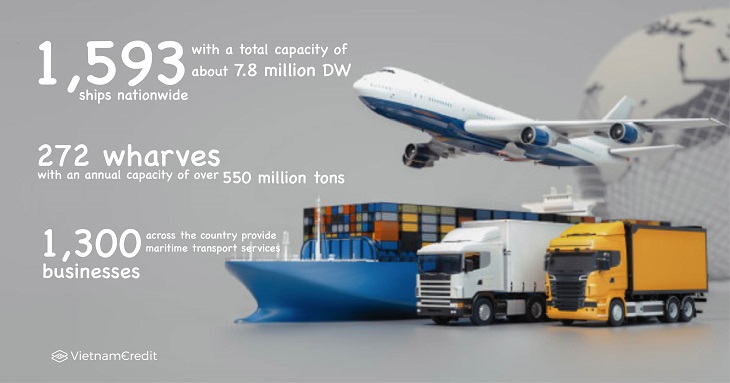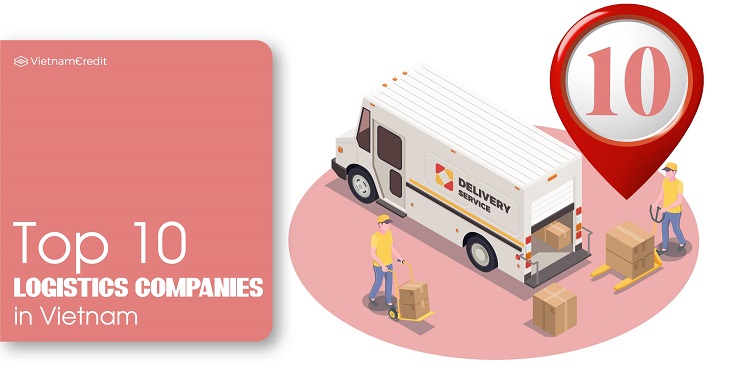According to the Vietnam Freight and Logistics Market - Growth, Trends, and Forecast (2019 - 2024) of Orbis Research, with a coastline of 3,260 km and a dense river system, Vietnam has a lot of potential for shipping transportation. In 2018, Vietnam's seaport approved 524.7 million tons of cargo, an increase of 19% compared to 2017.
Overview
Vietnam is entering a period of rapid development with a young population who is ready to apply new technologies, resulting in a vibrant domestic logistics market. High economic growth, increased domestic production, and high consumption are some of the main drivers of Vietnam's logistics industry.
In the past, poor transport infrastructure and high logistics costs were the constraints of Vietnam's logistics market. However, the current situation requires the industry to undergo a major change so that other industries can grow with it. The booming e-commerce has created great opportunities for logistics startups, especially in the field of delivery.
According to the Vietnam Freight and Logistics Market - Growth, Trends, and Forecast (2019 - 2024) of Orbis Research, with a coastline of 3,260 km and a dense river system, Vietnam has a lot of potential for shipping transportation. In 2018, Vietnam's seaport approved 524.7 million tons of cargo, an increase of 19% compared to 2017.
There had been 1,593 ships nationwide with a total capacity of about 7.8 million DWT as of December 2018, ranking 4th in ASEAN and 30th globally. In addition, Vietnam currently has 272 wharves with an annual capacity of over 550 million tons. About 1,300 businesses across the country provide maritime transport services, however, they have only partially met the needs of the market. The maritime logistics industry needs more investment, and as it grows, it can have a profound impact on the economy.
The Government plans to turn Vietnam into a powerful maritime nation by 2030, increasing the contribution of the maritime industry to GDP by 10%. Moreover, the government aims to increase the contribution of 28 coastal provinces to Vietnam's economy to 65% - 70% in the coming years, compared with only about 60% in 2017.
Total cargo throughput of Vietnamese seaports increased to 9.8% in the period of 2011-2017. Vietnam aims to increase this figure to 640 to 680 million tons per year to 2020 and 1,040 to 1,160 tons per year to 2030. The Government is also seeking to reduce its dependence on road transport and cut off the amount of goods transported on road.
On top of that, over the past 20 years, Vietnam has become one of the brightest production hotspots in Southeast Asia. From 1986 to 2018, land areas allocated to industrial zones increased impressively from 335 hectares to 80,000 hectares. Due to low labor costs, Vietnam has received a lot of capital over the years to set up assembly facilities and manufacturing plants.

Raw materials and mechanical parts for production and production purposes are among the main import items. Import and export activities are ongoing, requiring an efficient logistics industry to support the manufacturing industry.
Vietnam is currently an export-oriented economy. The government is encouraging business in the manufacturing sector and is attracting investment in this sector, by establishing economic and industrial zones. The manufacturing and processing industries have received the highest foreign investment over the years.
Fierce competition
In recent years, the number of businesses moving from China to Vietnam has been increasing. Rising costs in China, as well as President Donald Trump's tariffs are driving businesses to move production facilities to Southeast Asia. The geographic proximity makes Vietnam a viable option. Moreover, Vietnam has taken part in many free trade agreements (about 17 FTAs).
According to research firm Orbis Research, Vietnam's logistics market is very fragmented as most of the businesses involved are basically small and medium-sized companies, providing low value-added logistics. There are more than 3,000 logistics companies, and 90% of them have registered capital of less than VND 10 billion. Only 5% of these have capital of about VND 10-20 billion and, the other 5% have capital of more than VND 20 billion.
Competition among domestic logistics companies will be fierce in the future, and Vietnam's logistics and transport market are still dominated by foreign companies. Although foreign logistics companies account for a smaller share of the shipping volume, they account for 70% -80% of the logistics market's revenue. This highly fragmented nature is also limiting Vietnam's logistics potential to some extent.
>>> Vietnam logistics industry: risks and challenges
Compiled by VietnamCredit
























































